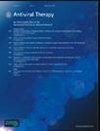Dolutegravir/rilpivirine 2药方案与常用的3药方案相比,在现实环境中长达18个月
IF 2.3
4区 医学
Q4 INFECTIOUS DISEASES
引用次数: 0
摘要
本研究在现实世界中比较了DTG/RPV与常用的3药方案(3-DR)在HIV感染者(PLWH)中的有效性和持久性。方法在OPERA®数据库中识别2018年启动DTG/RPV或3-DR的抗逆转录病毒治疗(ART)经验,病毒学抑制的PLWH,并随访至2019年6月30日。描述了病毒学失败(连续两次病毒载量(VL)≥200拷贝/mL或单次VL≥200拷贝/mL并修改/停药)和维持病毒学抑制(最后一次VL试验< 50或< 200拷贝/mL)。Kaplan-Meier方法用于估计病毒学失败和停止治疗的时间。在Cox模型中,根据年龄、性别、种族/民族、感染风险、地区、基线CD4细胞计数、药物滥用史或梅毒史以及基线死亡风险评分调整病毒学失败的风险。结果启动DTG/RPV的PLWH比3-DR启动者年龄更大,更可能是西班牙裔或有合并症。DTG/RPV使用者比3-DR使用者(分别为28%和96%)经历更少的停药(15%)和更有可能在研究结束时被抑制(98%)。病毒学失败不常见;在DTG/RPV组(1.45,95% CI: 0.69, 3.03)和3-DR组(2.63,95% CI: 2.21, 3.14)之间,每100人年的发病率没有差异。在校正Cox模型中,两组间病毒学失败的风险无显著差异(校正风险比1.32,95% CI: 0.61, 2.89)。这项真实世界OPERA®研究的结果表明,DTG/RPV可以作为标准3- dr的可行替代方案,用于art经历的病毒学抑制PLWH。本文章由计算机程序翻译,如有差异,请以英文原文为准。
Dolutegravir/rilpivirine 2-drug regimen comparable to commonly prescribed 3-drug regimens up to 18-months in a real-world setting
Background This study compared the effectiveness and durability of DTG/RPV with commonly prescribed 3-drug regimens (3-DR) in people living with HIV (PLWH) in a real-world setting. Methods Antiretroviral therapy (ART)-experienced, virologically suppressed PLWH who initiated DTG/RPV or a 3-DR in 2018 were identified in the OPERA® database and followed through 6/30/2019. Virologic failure (two consecutive viral loads (VL) ≥ 200 copies/mL or single VL ≥ 200 copies/mL with regimen modification/discontinuation) and maintained virologic suppression (last VL test < 50 or < 200 copies/mL) were described. Kaplan–Meier methods were used to estimate time to virologic failure and treatment discontinuation. Risk of virologic failure was adjusted for age, sex, race/ethnicity, risk of infection, region, baseline CD4 cell count, history of substance abuse or syphilis, and mortality risk score at baseline in a Cox model. Results PLWH initiating DTG/RPV were older and more likely to be Hispanic or have comorbidities than 3-DR initiators. DTG/RPV users experienced fewer discontinuations (15%) and were more likely to be suppressed at study end (98%) than 3-DR users (28% and 96%, respectively). Virologic failure was uncommon; rates per 100 person-years did not differ between the DTG/RPV (1.45, 95% CI: 0.69, 3.03) and 3-DR (2.63, 95% CI: 2.21, 3.14) groups. The risk of virologic failure did not differ significantly between the groups in adjusted Cox models (adjusted hazard ratio 1.32, 95% CI: 0.61, 2.89). Conclusions The findings of this real-world OPERA® study suggest that DTG/RPV can be a viable alternative to standard 3-DRs for ART-experienced, virologically suppressed PLWH.
求助全文
通过发布文献求助,成功后即可免费获取论文全文。
去求助
来源期刊

Antiviral Therapy
医学-病毒学
CiteScore
2.60
自引率
8.30%
发文量
35
审稿时长
4-8 weeks
期刊介绍:
Antiviral Therapy (an official publication of the International Society of Antiviral Research) is an international, peer-reviewed journal devoted to publishing articles on the clinical development and use of antiviral agents and vaccines, and the treatment of all viral diseases. Antiviral Therapy is one of the leading journals in virology and infectious diseases.
The journal is comprehensive, and publishes articles concerning all clinical aspects of antiviral therapy. It features editorials, original research papers, specially commissioned review articles, letters and book reviews. The journal is aimed at physicians and specialists interested in clinical and basic research.
 求助内容:
求助内容: 应助结果提醒方式:
应助结果提醒方式:


